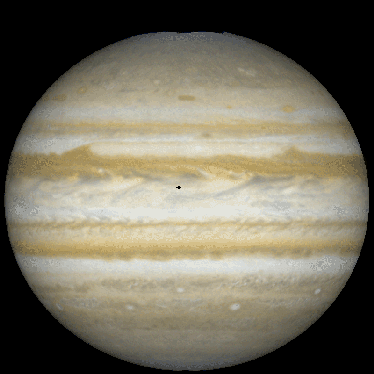

NOTE: Click on the image to view it at its highest resolution.
This view of Jupiter has been constructed from images obtained with the Hubble Space Telescope on Feb. 13, 1995. The predicted latitude and longitude of the entry site of the Galileo Probe is marked by the small black arrow near the center of the planet. These data were obtained with the Wide Field Planetary Camera 2 in the high resolution mode, which provides more than 800 samples from pole-to-pole on the planet. Because the disk of Jupiter is larger than the field-of-view of the camera, red, green and blue images from two consecutive orbits of the telescope are required to observe the whole disk. These data have been computer processed to provide this color image.
At the latitude of probe entry the visible clouds are swept eastward by strong prevailing winds at speeds of more than 200 miles/hour (110-120 m/sec), displacing the observed cloud structures about 7.5 degrees a day, thus in about 48 days the clouds will lap the entire planet.
Contact Reta Beebe for further information.
Reta Beebe Astronomy Department New Mexico State University FAX 505-646-1938 email rbeebe@nmsu.edu
Please note that earlier gif files had an error in where the arrow marking the
probe entry site appeared. The correct coordinates are: 4.46 W and 7.5 N
planetographic latitude and the corrected file was generated on 10/20/95.
![]() Images, Images, Images
Images, Images, Images
